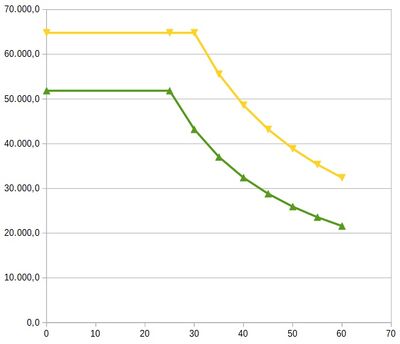Template:Table/Template:InheritValueTable
This template contains swapped content from page Template:InheritValueTable
This is an example for usage of <valueTable> with a series of two curves (force vs. speed) which are differentiated by a constant power limitation.
- railML®-Code
<valueTable yValueUnit="N" xValueName="speed" yValueName="tractive effort" xValueUnit="km/h" zValueName="Percentage power limitation" zValueUnit="%"> <columnHeader zValue="100" /><columnHeader zValue="66.7" /> <valueLine xValue="0.0"> <values yValue="64800" /><values yValue="51840" /> </valueLine> <valueLine xValue="25.0"> <values yValue="64800" /><values yValue="51840" /> </valueLine> <valueLine xValue="30.0"> <values yValue="64800" /><values yValue="43200" /> </valueLine> <valueLine xValue="35.0"> <values yValue="55542.9" /><values yValue="37028.6" /> </valueLine> <valueLine xValue="40.0"> <values yValue="48600" /><values yValue="32400" /> </valueLine> <valueLine xValue="45.0"> <values yValue="43200" /><values yValue="28800" /> </valueLine> <valueLine xValue="50.0"> <values yValue="38880" /><values yValue="25920" /> </valueLine> <valueLine xValue="55.0"> <values yValue="35345.5" /><values yValue="23563.6" /> </valueLine> <valueLine xValue="60.0"> <values yValue="32400" /><values yValue="21600" /> </valueLine> </valueTable>
When using the <valueTable> as representation of a series of curves (three-dimensional function) it shall be written in railML® similar as in a spreadsheet. It means first the header has to be defined with the value descriptions. Second the particular z-values valid for each curve out of the series are to be listed as child element <columnHeader>. Finally the respective <valueLine> for each x-value of the curves is included. Per each x-value there must be as much y-values as the number of curves (number of z-values). The order of y-values is according the order of z-values. Thus a clear assignment to the related curve is made. It shall be noted that the x-values may be not equidistant. In case the original series of curves have different x-values then interpolation must be used to get the missing y-values per each x-value occurring in the series.
